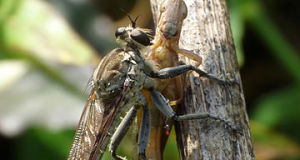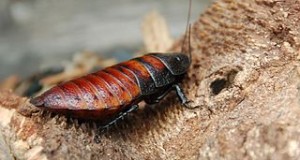 Assassin Bugs, while not the best known of invertebrate pets, are actually quite popular with insect specialists and in public collections. I began working with 2 African species in the early 80’s, and soon built up a collection of native forms as well. Recent studies at Australia’s Macquarie University have revealed that one Assassin Bug captures spiders by tweaking their webs in imitation of a trapped insect. I’ll cover the care of some commercially available Assassin Bugs in Part 2.
Assassin Bugs, while not the best known of invertebrate pets, are actually quite popular with insect specialists and in public collections. I began working with 2 African species in the early 80’s, and soon built up a collection of native forms as well. Recent studies at Australia’s Macquarie University have revealed that one Assassin Bug captures spiders by tweaking their webs in imitation of a trapped insect. I’ll cover the care of some commercially available Assassin Bugs in Part 2.
Hunting the Hunters
Assassin Bugs are predatory insects of the Order Hemiptera (insects with piercing mouthparts). Most lie in wait for invertebrates to stray within reach, others feed upon blood, and a few employ elaborate ruses in order to trick their prey within striking range.
The Australian species studied at Macquarie University lures spiders close by plucking at their webs. As anyone who has tried to lure a spider out of hiding knows (yes, I have tried…often and in many places!), they can be quite discriminating in deciding what sort of disturbance to investigate. Analysis of the web vibrations produced by Assassin Bugs revealed that they exactly matched those made by a trapped insect. This hunting strategy, known as Aggressive Mimicry, is used by certain spiders but had not been observed in insects.
Bait-Users and Blood-Suckers
Other species of Assassin Bugs hold dead termites in their jaws when hunting. This either hides the Assassin or encourages other termites to investigate, there by assuring the hunter an easy meal.
While doing some work at an insectarium in Ohio, I had the chance to observe Assassin Bugs that fed upon mammal blood. However, providing a live mouse to a hoard of ravenous insects was not deemed a suitable public exhibit, so the little beasts were held for behind-the-scenes study (blood-feeding Assassins spread Chagas Disease and other serious illnesses).

Assassins in Captivity
West Africa’s White-Spotted Assassin Bug (Platymeris biguttatus) and the Red-Spotted Assassin (P. rhadamanthus) of East Africa are the species most commonly offered for sale in the USA. I’ll cover their care in Part 2 of this article.
A number of North America’s many native species make fascinating terrarium subjects as well, although none are as easy to breed or as are the African imports. The East Coast’s 1.5 inch Wheel Bug (Arilus cristatus) is, however, very interesting and well-worth some attention from insect fanciers (please see photo)…more on these and other species in Part 2.
Further Reading
Care and Natural History of the Red-Spotted Assassin Bug .
Videos of a wide variety of Assassin Bugs.
Assassin Bug Nymph image referenced from wikipedia and originally posted by Aurelius787
 That Reptile Blog – Reptile, Amphibian and Exotic Pet Care and Information
That Reptile Blog – Reptile, Amphibian and Exotic Pet Care and Information



